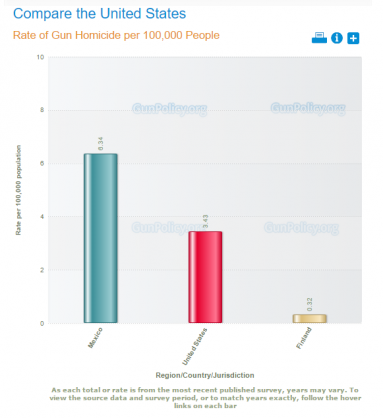Gun violence is an undeniable problem in the United States, but as with so many social issues, our perception of it is constrained by a deeply ingrained chauvinism, an American exceptionalism that is both self-righteous and hypocritical. “Gun violence” is our embarrassment, as a “developed nation,” as civilized, advanced, and wealthy. And so we divide the rest of the world between two categories. There are states with fewer gun deaths than ours, with whom we imagine ourselves as being on a parallel plane of sophistication, and whose superior track record shames us. And there are the squalid, undeveloped hellholes with more gun deaths than ours. We might make billions destabilizing their regimes and flooding their borders with weapons, but our complicity in that violence is not what shames us. Our shame is the fear that “we” might somehow be like “them.”
Nowhere are the ugly pretzels of this exceptionalism more visible than in debates over “America’s Rifle,” the AR-15. It has often been argued that the AR-15 was meant for the American military, and was never intended for civilian use. The family of the Eugene Stoner (the engineer who was primarily responsible for developing the weapon’s key features), recently made news by asserting that Stoner never intended civilians to possess the weapon. Stoner’s personal intentions notwithstanding, the history is rather more complicated.
Frequently mis-glossed as “Assault Rifle,” the AR in “AR-15” refers to its original manufacturer, Armalite. Of course, the key patent was filed sixty years ago and has long since expired; today, “AR-15” is a trademark of Colt Defense LLC and, over the years, “AR-15” has evolved into a generic trademark, a proprietary eponym like Velcro, Kleenex, Xerox, or Tupperware. Civilian AR-style rifles encompass anywhere between four to nine million weapons used for purposes ranging from recreational target shooting to varmint and predator hunting to simply being kept under beds, in closets, or on mantles. When adopted by the military in a version capable of fully automatic fire, the AR-15 was dubbed, per military nomenclature, the M-16; this has, in turn, birthed a wide variety of variants and successors, from the HK416 used to kill Osama Bin Laden to the M4s and M16A2s carried by American soldiers worldwide.
Many of these rifles have retained superficial similarities with the original AR-15 while also departing significantly from it. A key feature of the original AR-15 design involved capturing some of the gas rushing down the barrel through a tube, and then feeding it backwards to advance the rifle’s cycle of operations. Many ARs still rely on this system (known as “direct impingement”). But some modern successors employ a piston, and thus aren’t really ARs at all. Inevitably in the firearms world, ingenious design innovations frustrate civilian observers and legislators alike. Thus, despite superficial similarities, the Sig Sauer MCX wielded by the Orland shooter is not an AR-15, and a weapon like this is neither technically an AR nor even a rifle: it’s a pistol that you can turn into a rifle (in the eyes of the ATF, illegally) depending on how you hold it. One point, though, is important to emphasize: unless they go through a particularly arduous and expensive licensing process, American civilians can only possess ARs lacking features present in the military variants: most notably, fully automatic fire, but also short barrels and various stock configurations.

